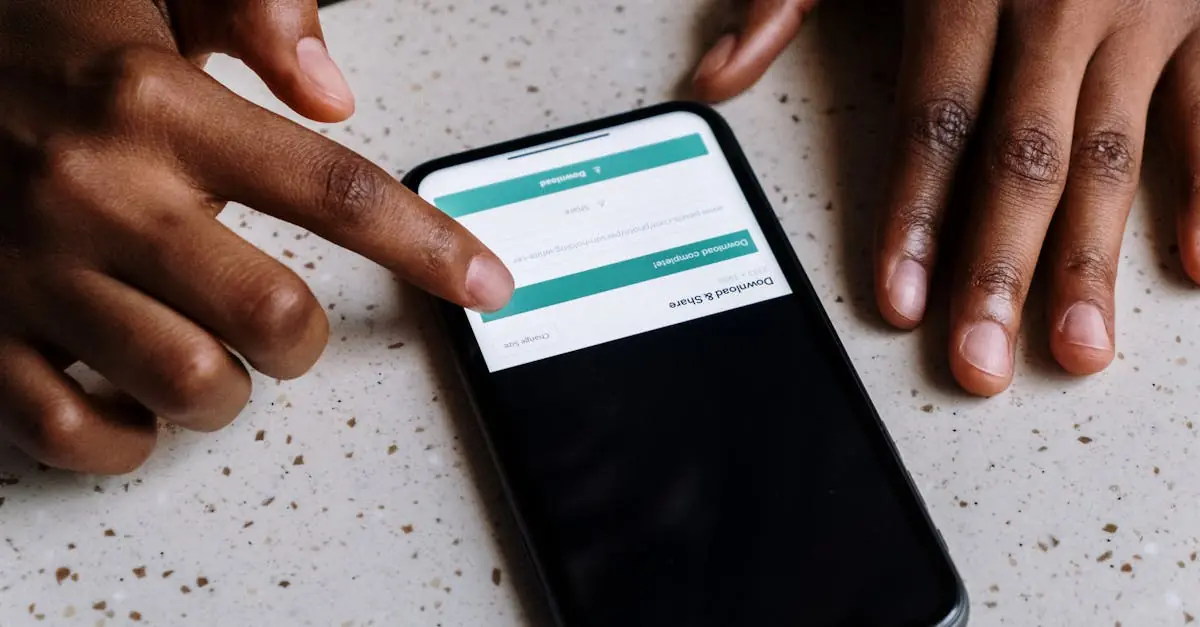Table of Contents
ToggleEver hit that download button on your iPhone and then wondered where the heck it all goes? You’re not alone. Many iPhone users find themselves in a digital scavenger hunt, searching for their recently downloaded treasures. It’s like playing hide-and-seek with your favorite apps, photos, or documents.
Understanding Downloads on iPhone
Downloads on an iPhone can create confusion regarding their location. Users often wonder where their files go after downloading.
Types of Downloads
iPhones accommodate various downloads, including apps, images, and documents. App downloads typically appear on the home screen, ready for immediate access. Images downloaded from Safari go directly to the Photos app, stored in the Camera Roll. Document downloads often save to the Files app, which organizes and indexes different types of content. Cloud-based downloads may also sync with related apps like iCloud Drive, making them accessible across devices.
Common File Formats
Common file formats found on an iPhone include JPEG, MP4, and PDF. JPEG files represent images captured with the camera or downloaded from the web. MP4 files store videos, allowing playback within the Photos app or compatible video players. PDF files serve as documents, often downloaded from the internet for viewing or sharing. Each format has a designated application for easy access, ensuring seamless management of downloaded content.
Where Are Downloads Stored?
Determining the location of downloads on an iPhone often invites confusion. Users must explore specific apps to locate their files efficiently.
The Files App
The Files app serves as a centralized hub for managing documents. Users can find all types of downloaded files, including PDFs and Word documents, within this app. By accessing the Files app, individuals can browse through categories like Recent or Browse to discover where their downloaded items are saved. This feature allows for easy organization and retrieval of important documents. Additionally, files saved in iCloud Drive sync across devices for seamless access on other Apple products.
Default Locations for Different Apps
Different apps utilize specific locations to store downloads. For instance, images downloaded from Safari automatically go to the Photos app. Files received through email arrive directly in the Mail app’s Downloads folder. App downloads appear on the home screen immediately after installation. Each application manages its downloads uniquely, ensuring users can find their files within the appropriate context. Understanding these default locations enhances the efficiency of finding downloaded content on an iPhone.
Managing Your Downloads
Managing downloads on an iPhone simplifies locating and organizing files. Understanding where files go after downloading helps users access content quickly and ensure a clutter-free device.
Accessing and Organizing Files
Users can find downloaded files primarily in the Files app, which serves as a centralized hub for managing documents. Various categories, such as Recent and Browse, aid in locating items efficiently. Images downloaded through Safari appear in the Photos app, while files from email save to the Mail app’s Downloads folder. Users can create folders within the Files app to sort and organize downloaded data. This organization method keeps documents easily accessible and minimizes search time for essential items.
Deleting Unwanted Downloads
Deleting unwanted downloads helps maintain storage space and organization. Users can remove files from the Files app by selecting a file and tapping the Delete option. Items in the Photos app may be deleted through the Albums tab by selecting photos and choosing the Delete button. Deleted items don’t vanish immediately; they go to the Recently Deleted folder, where users can recover files within 30 days if needed. Regularly reviewing downloads allows users to clear out unnecessary files, thus optimizing device performance.
Troubleshooting Download Issues
Download issues can disrupt the user experience on an iPhone. Identifying and resolving common problems leads to smoother functionality and better access to downloaded content.
Common Problems and Solutions
Slow download speeds often cause frustration. This situation may arise from a weak Wi-Fi connection or cellular data limits. Restarting the device or resetting network settings can mitigate these issues effectively. Missing downloaded files also perplex many users. An iPhone may not immediately display recent downloads on the home screen. Users should check the Files app for documents or other related apps for specific file types. App downloads, however, should appear on the home screen promptly. Finally, issues with iCloud settings can hinder the synchronization of cloud-based downloads. Ensuring that the correct iCloud account is active resolves many access problems.
Tips for Better Download Management
Organizing downloads simplifies file retrieval. Users can create folders within the Files app to categorize documents by type or project. Frequent reviews of the Downloads folder help identify unwanted files. Deleting items no longer needed frees up storage space and enhances device performance. Utilizing tagging features within the Files app allows for better sorting and quick access. Activating automatic backups in iCloud or alternative cloud services ensures important downloads remain available across devices. With these strategies, managing downloads becomes more efficient and less time-consuming.
Finding downloaded files on an iPhone doesn’t have to be a challenge. By understanding where different types of downloads are stored users can navigate their devices more efficiently. The Files app serves as a vital tool for organizing and managing documents while the Photos app is the go-to for images.
Regularly reviewing downloads and utilizing folders can greatly enhance accessibility. Troubleshooting tips ensure that any download issues are addressed promptly. With these strategies in place users can enjoy a smoother experience when managing their downloads on an iPhone.




